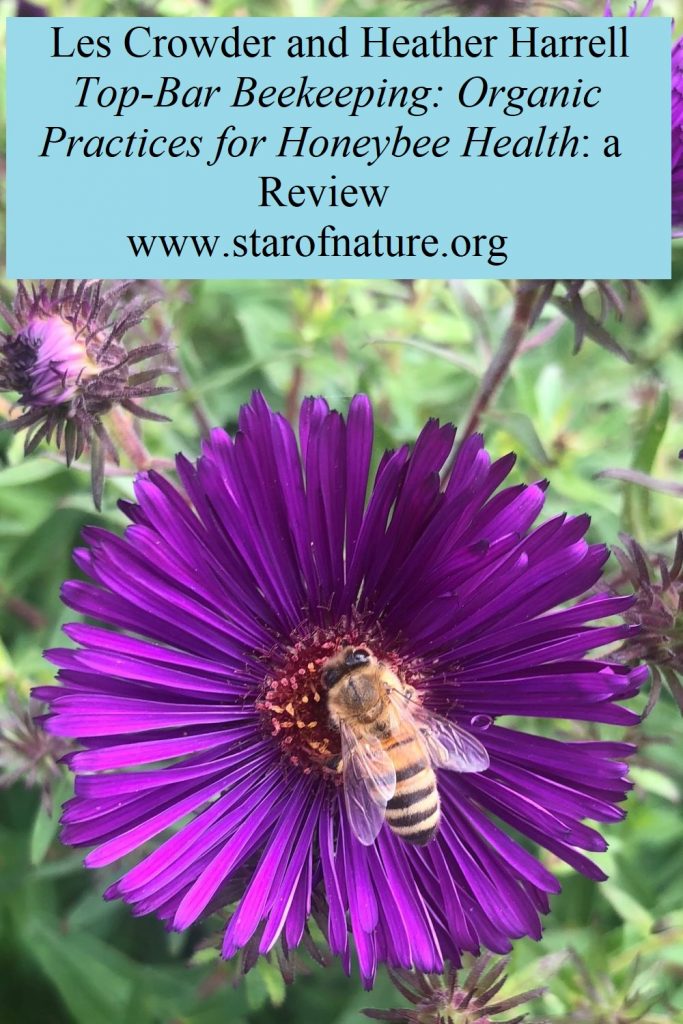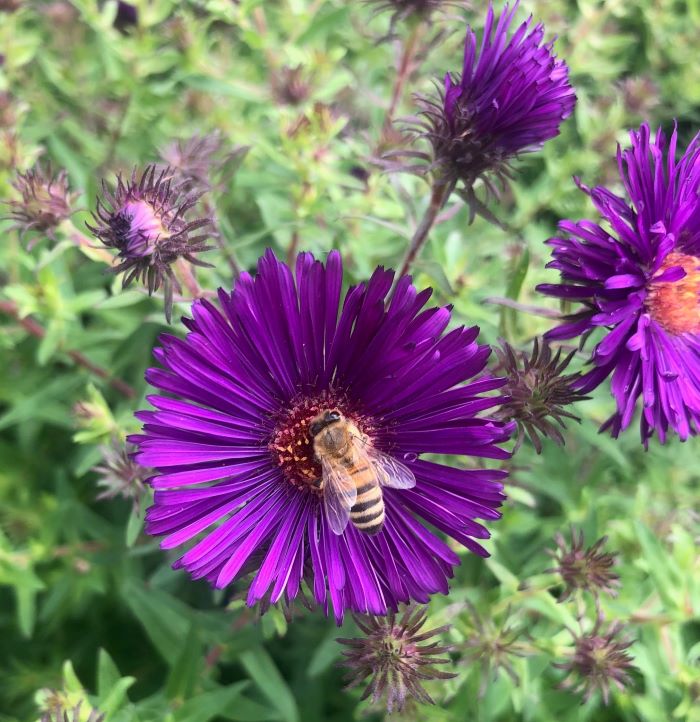Les Crowder and Heather Harrell, ‘Top-Bar Beekeeping: Organic Practices for Honeybee Health’: a Review
Les Crowder and Heather Harrell, Top-Bar Beekeeping: Organic Practices for Honeybee Health (Vermont: Chelsea Green Publishing, 2012) is the best and the most detailed introduction to top-bar beekeeping currently available. But it is much more than this.
It is a book I would recommend to everyone, not just the beekeepers. It is highly engaging and written in a non-technical language. Most importantly, it educates about commercial beekeeping. Since honey and other bee-products are marketed as ‘healthy’ and ‘natural’, it is essential reading for anyone concerned about the environment and one’s own health.
For a beekeeper it is a valuable book independently of experience. It will teach a beginner techniques that allow bees to thrive without the use of antibiotics, bee repellents, insecticides, and fungicides. To an experienced beekeeper it offers sensible and honest advice on the economic aspects of organic beekeeping.
Connection to the beautiful life
In the introduction Les Crowder describes a walk he took as a teenager with his grandfather. Seeing a mint patch in full bloom, covered with bees, he experienced a life-changing moment. He knew that he would taste the nectar from mint once it was made into honey by the bees. The soil, the mint roots and flowers, the sun, the water, the bees, he and his grandfather – all felt connected and part of ‘the vibrant pulse of warm, beautiful life’ (p. xii).
This sense of connection to the world and awareness of one’s impact on it is evident throughout Les Crowder’s book.
Poisoned world
Inspired by many years of experience, Crowder advocates keeping bees respectfully and organically. And his career in beekeeping gave him the first-hand knowledge of the commercial beekeeping that was and is ‘like the rest of industrial agriculture, rife with exploitation and chemicals’ (p. xiii).
Organic beekeeping requirements
Les Crowder observes that though the standards of organic beekeeping differ from country to country, they generally advise that:
- beekeepers use hives made from natural materials that are not treated with any chemicals
- bees build their own combs, rather than use combs made from plastic, and forage in an unsprayed environment
- bees are not fed sugar syrop or pollen substitutes, or treated with chemical inputs of any kind.
Chemical build-up in beehives
This, however, is difficult to achieve with standard beehives, such as the Langstroth hives popular in the USA.
The combs used in Langstroth hives are not made by bees. They used to be made from wax, imprinted with cells designed to maximize the honey production. Industrial beekeepers, however, increasingly use the ‘foundation’ made from plastic.
Once honey is harvested, the combs are stored for winter in the hope of reusing them the following season and thus minimising the costs.
The storage, however, creates problems because wax moths and mice will eat and destroy the comb. In commercial beekeeping the frames with comb are fumigated with paradichlorobenzene to keep these and other pests away. Paradichlorobenzene, used in moth balls, is a known carcinogen. Nevertheless the comb treated with this chemical is placed back into beehives in spring to be refilled with honey.
The comb also gets dirty from re-use and visibly changes its colour from pale yellow to black. This happens because of a build-up of old cocoons and bee waste, not to mention antibiotics, insecticides, pathogens and toxins from the environment.
Miticides in beehives
The problems with the comb are far from being the only ones. Les Crowder reports that in 2008 he worked as an inspector for an almond plantation in California during the time that the Colony Collapse Disorder was hitting the bees hard. He saw countless dead and empty colonies, full of black combs and with multiple strips of miticide hanging in them.
Miticidal strips are meant to be administered for a specific amount of time and then removed and disposed of as hazardous waste. But most beekeepers don’t know what to do with hazardous waste and the strips end up in the landfill. Due to the lack of resources at the time Crowder describes, beekeepers were neglecting to remove the strips at the recommended time and were instead putting strip after strip inside the hives.
While Crowder was an inspector, the lab tests showed that the levels of miticide in hives became lethal for bees. But it was not only the bees that were paying the price. Miticides are just one of the many chemicals that are wax-soluble and thus make their way into bee products.
Top-bar beekeeping pros and cons
Organic practices in top-bar beekeeping
Les Crowder insists that top-bar beehives easily accommodate organic requirements. For example, in top-bar hives there is no artificial ‘foundation’ and bees make their own comb. There is therefore no need to store it and it is constantly renewed, which eliminates the problem of the build-up of chemicals.
Simple design of top-bar beehives
Crowder also points out that the design of the top-bar beehive is extremely simple. The hives can even be made cheaply by beekeepers themselves. He provides drawings and dimensions that can be followed by anyone willing to do this.
Varietal honeys in top-bar beekeeping
A chapter on varietal honeys points out that one of the advantages of the top-bar beekeeping is that each variety of honey, collected from different plants, can be isolated and bottled separately.
Langstroth hives requires expensive equipment. They need extractors that pull the honey out of the combs that are then reused. The running of the extractors is not justified with small batches of honey. Beekeepers therefore delay their use until they have a large batch to extract.
For a producer of varietal honey, however, it is in one’s interest to harvest honey after the flowering of each plant, in order to bottle and sell unique flavours. This is easier with top-bar beehives that don’t require extractors, since comb is not reused after harvesting.
Disadvantages of top-bar beehives
Crowder admits, however, that traditional hives, such as Langstroth, have certain advantages, particularly for a commercial beekeeper. They include increased honey production, potentially less maintenance throughout the season, and greater ease of loading and transporting the hives for commercial pollination.

Basics of top-bar beekeeping
Les Crowder’s book is entirely appropriate for a beginner and is an excellent choice for someone’s first book on beekeeping. He explains bees social organisation, behavioural patterns, including stinging, and how beekeepers interact with bees. He advises on what clothing to wear, how to choose a position for a beehive, how to use a smoker, and how to protect hives from animals such as mice and ants.
In a chapter on obtaining bees, he explains different options, such as buying a package, catching swarms, trapping colonies and removing hives built in inappropriate places, such as old sheds or barns. He praises obtaining a nucleus hive from a local beekeeper, arguing that some of the best bees are the ones that have already adapted to the area.
How to help the bees
Les Crowder starts his chapter on hive management by observing that a top-bar hive is similar to bees’ natural home inside a log. Bees can therefore potentially live in it for many decades without human interference. If the conditions are favourable, wax moths will live symbiotically with the hive, culling old dark combs, and ‘the hive will wax and wane continuously’ (p. 45).
However, Crowder does not at all think that beekeeping for honey should be abandoned, and does not advocate switching entirely to conservation hives without human interference.
There are several videos with Les Crowder’s interviews and lectures on YouTube. He discusses this question there as well and says that his answer to people who simply want to help bees is to grow flowers.
In Top-Bar Beekeeping he says:
We hear from many new beekeepers that they do not want to disturb their bees, so they rarely look inside their hives. We encourage them to spend more time with their bees, forming an alliance that is comfortable and effortless’ (p. 63).
Crowder believes that a mutually beneficial symbiotic relationship of humans and bees is the best way forward.
Top-bar beehive management
Les Crowder explains what to do if a beekeeper desires to harvest honey. If this is the case, hive management is necessary, and he describes how to do it with a top-bar hive.
Crowder explains in detail how to prevent cross-combing and describes configurations of the hive appropriate for different seasons and situations. These are illustrated with many useful drawings.
Feeding the bees
Discussing whether to feed the bees Les Crowder argues that it is rare that an established hive needs feeding, as long as the ‘beekeeper is conscientious about leaving the hive with enough of its own resources’ (p. 64). He accepts, however, that the colony needs to be fed if it is in the danger of starvation, despite the beekeeper’s best efforts.
Discussing the choice between sugar and honey, Les Crowder argues that honey is without question the best food for bees. As for the pollen substitutes, he points out that in his more than 30 years of beekeeping, he has never seen a hive to starve to death because of pollen shortage. The supplements are mainly used by commercial beekeepers to create artificial growth of colonies in environments in which monoculture predominates, and there is not enough plant live to sustain bee populations.
Crowder includes detailed chapters on seasonal tasks, such managing swarming, making divides, combining hives, hive insulation and other. The book also has two extensive chapters on evaluating and raising queens.
The book ends with a chapter on planting for bees. Every gardener should read it, as it describes bee-friendly trees, shrubs and flowers that provide food for pollinators and improve honey production.
Problem solving in top-bar beekeeping
The chapter on problem solving in top-bar beekeeping explains organic methods of dealing with chalkbrood, foulbrood, varroa mites, nosema, wax moths and other diseases. It also includes a description of the symptoms of insecticide poisoning.
Les Crowder observes that recent research has shown that chalkbrood may be caused by the application of fungicides in areas where bees are foraging for pollen. He says that they had experience with this phenomenon when they took their hives to pollinate almonds in California. They were careful to choose an organic farm to pollinate. But the environment in the Central Valley of California, where almonds are grown, is so contaminated with fungicides and other chemical applications that their bees showed multiple signs of illness.
The chapter on the Colony Collapse Disorder (CCD) explains this devastating condition. This is when beekeepers find that the hive is full of honey, traces of brood and perhaps a queen with a small handful of bees. The workers, however, have simply abandoned the hive never to return.
Scientific research links this disastrous condition to the use of a class of pesticides called neonicotinoids. These are neurotoxins that cause nerve damage, making insects incapable of functioning normally. Many countries have banned neonicotinoids finding them to be the cause of CCD.
It is not just honeybees, but pollinators of every kind that are at risk of this type of damage. Their very existence is threatened by the use of these chemicals. And, as Les Crowder remarks, places where no insecticides are being used are increasingly hard to locate.
Honey products
Chapter 6 describes harvesting honey, bee wax and other products in top-bar beekeeping. As elsewhere, Les Crowder gives detailed instructions on harvesting and bottling honey organically.
He notes, for example, that honey should be processed in a clean environment free from mice, ants and other insects:
‘Cleaning up the floor with soapy water and then a little lavender water can keep ants out’ (p. 9).
Crowder observes that because honey is very acidic, they bottle it only in glass jars. Honey absorbs flavours and sensitive individuals will taste the plastic it has been stored in.
Crowder also says that a common image that makes them cringe is one of a plastic honey bear being microwaved to re-liquify the honey while also degrading the plastic molecules (p. 96). How true!
Raw honey
Explaining about raw honey, Les Crowder says that there are no regulations in the USA to legislate the definition of raw honey. Even honey that has been pasteurized can be labelled raw without any legal consequence.
Most consumers are used to liquid honey sold in supermarkets. It has been heated and strained to eliminate all potential for crystallization. Whereas honey that has never been heated will crystallize at some point, often within weeks of harvesting. As Crowder explains:
‘Because raw honey that is hand-crushed is rich with the flavor of pollen and propolis, and is still alive with enzymes, most people who taste it will be amazed at how good it is, as well as how different it is from commercial products’.
I can certainly testify to being amazed at how different and wonderful unprocessed raw honey tastes. My own revelation happened at a Christmas market in Vienna. In the UK, however, it is nearly impossible to buy such honey.
How honey should be labelled
Les Crowder explains how honey should be labelled. Labels should state that it is raw or unheated, free from antibiotics or miticides, and unfiltered. They should also include a date and place of harvest. Have you seen such labelling and such honey in your area?
Organic bee wax
Les Crowder also describes in detail how to harvest and process wax. He notes that since top bars beehives provide a lot of wax, they can add to a beekeeper’s income, even though they produce less honey.
If wax has been produced in hives that have not been treated with miticides, it is become exceptionally valuable because it is free of toxins.
In one of his interviews on YouTube Les Crowder observes that Japanese cosmetics companies have stopped buying commercially produced wax from the USA, because it is so badly contaminated with chemicals.
Much commercial bee wax has also been bleached because it is commonly derived from combs that are discarded once they turned very black and are no longer suitable for honey production.
Canary in the coal mine
Les Crowder observes that our bees are like the canary in the coal mine, telling us when an area is too poisonous (p. 129). As such beekeepers are a small, but ‘increasingly noticeable rock in the shoe of modern agriculture’, putting pressure on it to find non-poisonous methods of growing food.
In his ‘Conclusion’ he observes that it used to be said that beekeepers could not plant enough flowers to make a difference for bees. But in the modern world of pollution and fast loss of biodiversity, there is no choice but to try.
His final call to action is:
‘In the world we find ourselves in today, no garden and no prayer of support for nature is too small’ (p. 160).
Posts related to ‘Les Crowder and Heather Harrell, ‘Top-Bar Beekeeping: Organic Practices for Honeybee Health’: a Review’
What is Nectar: Basics for a Bee-Lover
Pollen: Basics for a Bee-Lover
What are the Best Nectar-Producing Flowers for Bees?
How to Make your Vegetable Garden Bee Friendly
Lemon Balm or Melissa – What does it Do for Bees?
‘Wilding’ by Isabella Tree: a Review
Growing Your Own Food: Why Organic is better?
Pin ‘Les Crowder and Heather Harrell, ‘Top-Bar Beekeeping: Organic Practices for Honeybee Health’: a Review’ for later

